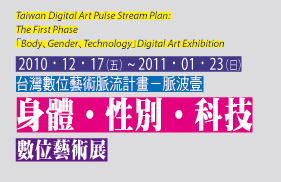Curator's Preface
Lin, Pey-Chwen
Professor & Director of the Digital Art Laboratory
Department of Multimedia and Animation Arts, National Taiwan University of Arts
Throughout history, “technology” can be seen as humanity’s breakthroughs where new technical skills, media, and ways of thought are developed. This was the case for the invention of photography, whose impact on humanity far exceeded original intentions. From photography and video recording to computer technologies, electronics, and the Internet... all of these represent revolutions in lifestyle and thought. Progressive artists have always been eager to transform these new technologies into media and concepts for creating art. For example, in futurism art, concepts of motion and time incorporated in images, whereas, kinetic art began when motors where invented. After the invention of electronic, video, television, mass communication, digital technology, computer, and Internet technology, many dynamic art forms subsequently flourished. Artists not only use new technologies as their creative medium, they also use it to foster unique creative perspectives. For example, Cindy Sherman’s photographic works present the phenomenon of mass media’s commoditization of the female body, while Barbara Kruger’s photography uses advertisement slogans to criticize violence in the media. Nam June Paik worked with a variety of media, such as television and video recorders, and is considered to be the first video artist. Bill Viola also uses digital images to explore themes such as the body, life and death. Ken Goldberg and Joseph Santarromana, creators of the “The Telegarden,” used interactive Internet devices to create works that serve as reflections on the contrast between virtual technology and nature. Thus, in each era, “technology” has been the limitless inspirational source for artists, while also being an era’s language of art or even the subject of criticism.
The goal of organizing the digital art exhibition, “Gender, Body, and Technology,” is to showcase Taiwanese artists’ new, dynamic and creative approaches in creating artworks using digital media, as well as to document the entirety of Taiwanese digital art from different perspectives. Therefore, Liao Xin-Tien, Chen Ming-Hui, Chiu Chih-Yung, Loh Li-Chen, and Tseng Yu-Chuan have been specially invited to join the curating team for this exhibition. Preliminary discussions regarding the exhibition’s theme included topics such as “Gender, Body, and Technology,” “Nature and Artificial,” “Space and Media,” “Flow and Time,” and “Metaphor and Narrative.” However, due to spatial constraints at Digital Art Center, an interactive platform format that showcases the chronology of Taiwan’s digital art and introduces some future exhibitions has been designed to account for this event’s capacity limitations. The actual works on display were recommended by a team of curators. As a result, the curators are also participators. The decision to retain this list of artists took into account the fact that contemporary artists often don multiple roles. For example, Tseng Yu-Chuan is an Internet Artist as well as an academic researcher of digital art; Loh Li-Chen who, besides her creative work and teaching duties, is also involved in research on the history of Taiwan’s digital art. The curating of an exhibition based on an artist’s perspective must be different than one with a purely research perspective. Furthermore, feminist art researcher, Chen Ming-Hui, has been invited to take part in this exhibition to incorporate her perspective on “genders.” An example of her curated works can be seen in the international exhibition, “0&1, Cyberspace and the Myth of Gender,” where “0” and “1” were used as analogies to the two genders. Chiu Chih-Yung’s professional experience in digital art and communication is a great asset for inspecting the “Taiwan Digital Art Pulse Stream Plan.” At the same time, Liao Xin-Tien’s broad perspective is instrumental in defining digital art’s relevance to our times.
To plan this exhibition, I am using the same creative perspective I use to organize personal exhibitions. For example, “The Portrait of Eve Clone” is my warning towards the disaster that technology civilization will bring to humankind. From the reproduction of illusions of artificial naturalness in my earlier digital images to more recent use of digital images, interactive programs, and holograms, I criticize the virtual nature of artificial life. Works of participating artists that share the same reflections on technology include: Kuo Hui-Chan’s “Bubble Man” mirrors her belief that, with the spread of computer technology, excessive information will make people live in constant fear and anxiety of becoming outdated; Yu Chung-I’s “Lost my focus-whisper” reflects the blurred fantasy and anxiety that modern people live in when looking through the multiple windows of digital information media. Therefore, all of the exhibited works involve issues that intersect “body, gender, and technology” in some manner, letting viewers see how Taiwanese contemporary artists fully express the unique creative character of their works through digital media.
Special thanks are accorded to Tseng Yu-Chuan for her efforts in writing the project proposal, confirming artworks, completing grant applications, designing promotional materials, producing an interactive timeline about the development of Taiwan’s digital art, planning the exhibition space, and putting together the forums. Her professional and dedicated attitude is worthy of praise and admiration. Also, a big thank you to all curators, artists, and forum participants; Professor Lai Wen-Shu for providing research papers for this exhibition; Taipei Digital Art Center for co-hosting; Council for Cultural Affairs; Taipei Department of Cultural Affairs; Taiwan Technology Art Education Association; Association of the Visual Arts in Taiwan and Taiwan Women’s Art Association for their sponsorship and support. I look forward to all your efforts in gradually completing the “Taiwan Digital Art Pulse Stream Plan.” Finally, I would like to take this time to pay my deepest respects to a dear, late friend and Infodate’s founder, Professor Chang Tien-Chun. She had dedicated her entire life to education, and her strong influence on many students can still be felt. She will forever be remembered as one of the most important scholars, artists, and educators in the field of tech art education in Taiwan. With that said, I would like to dedicate this exhibition in honor of her great love and contributions.

